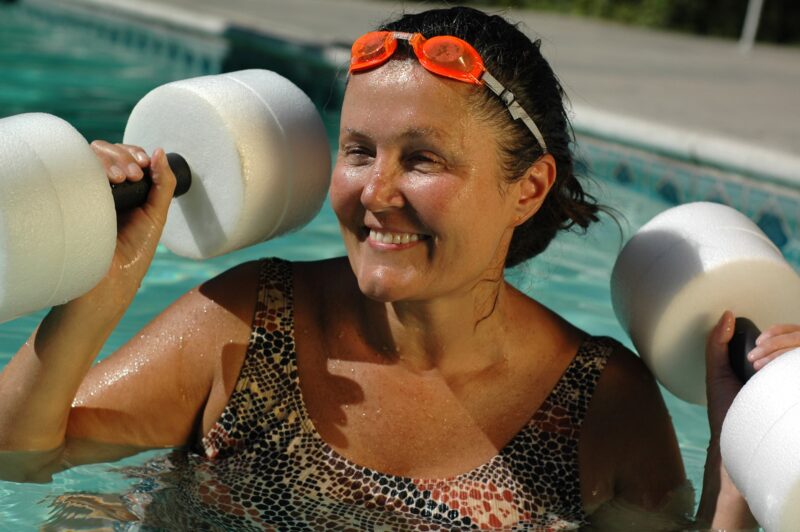Aquatic therapy, also known as hydrotherapy or pool therapy, has been utilized for centuries as a therapeutic method for various health conditions. In recent years, its benefits for spinal conditions have gained significant attention among healthcare professionals and patients alike. This form of therapy involves performing exercises in the water, typically in a heated pool, under the guidance of trained therapists. Let’s delve into the numerous advantages of aquatic therapy for individuals with spinal conditions.
What spinal conditions can aquatic therapy help?
Aquatic therapy has been found to be beneficial for a wide range of spinal conditions. Here are some of the spinal conditions for which aquatic therapy is especially effective:

- Degenerative Disc Disease (DDD): This condition involves the breakdown of intervertebral discs, leading to pain and limited mobility. Aquatic therapy can help alleviate pain and improve flexibility by reducing the pressure on the discs.
- Spinal Stenosis: This condition is characterized by the narrowing of the spinal canal, which can compress the spinal cord and nerves. The buoyancy of water in aquatic therapy allows for easier movement and reduced pain.
- Herniated or Bulging Discs: The buoyancy of water reduces the gravitational pull on the spine, which can help in relieving the pressure on the affected disc and surrounding nerves.
- Spondylolisthesis: This is a condition where one vertebra slips forward over the one below it. Aquatic exercises can strengthen the muscles supporting the spine, providing stability and pain relief.
- Post-operative Rehabilitation: After spinal surgeries like laminectomy, discectomy, or spinal fusion, aquatic therapy can be an effective way to regain strength, mobility, and flexibility without putting undue stress on the healing spine.
- Sciatica: Caused by the compression of the sciatic nerve, this condition can lead to pain, numbness, and tingling in the lower back and legs. Aquatic therapy can help in reducing muscle tension and inflammation, alleviating symptoms.
- Chronic Lower Back Pain: Whether due to muscle strain, ligament sprain, or other underlying conditions, chronic lower back pain can benefit from the pain-relieving and muscle-strengthening properties of aquatic therapy.
- Ankylosing Spondylitis: This is a type of arthritis that affects the spine. The warm water in aquatic therapy can help in reducing muscle stiffness and improving mobility.
- Scoliosis: While aquatic therapy cannot correct the curvature of the spine in scoliosis patients, it can help in managing pain, improving posture, and enhancing overall spinal function.
- Spinal Arthritis: The resistance of water can help in strengthening the muscles around the joints, while the buoyancy can reduce the impact on the arthritic joints, providing relief from pain and stiffness.
It’s essential to note that while aquatic therapy can be beneficial for many spinal conditions, it may not be suitable for everyone. Factors like the severity of the condition, the presence of other health issues, and individual preferences can influence the effectiveness and appropriateness of aquatic therapy. Always consult with a healthcare professional or physical therapist to determine if aquatic therapy is right for your specific condition.
Advantages of Aquatic Therapy
Buoyancy Reduces Pressure on the Spine
Aquatic therapy, conducted in the buoyant environment of water, offers a unique advantage in reducing spinal pressure. When submerged in water, the human body experiences an upward force known as buoyancy, which counteracts the downward pull of gravity. This buoyant force diminishes the weight-bearing load on the spine, allowing individuals to move with a fraction of their land-based weight. As a result, the vertebral discs and adjacent structures experience less compressive force, facilitating easier and pain-free movement. The depth of immersion further influences this effect; the deeper one goes, the greater the buoyancy and the lesser the stress on the spine. By alleviating gravitational strain, aquatic therapy provides a therapeutic environment where the spine can heal and function with minimal pressure, making it an ideal modality for those with spinal conditions or pain.
Resistance Enhances Muscle Strength
Water resistance plays a pivotal role in enhancing muscle strength, especially in the context of aquatic therapy for the spine. Unlike air, water offers multidirectional resistance, meaning that every movement made in water, whether it’s a simple stretch or a more complex exercise, is met with a consistent opposing force. This resistance challenges the muscles surrounding the spine, compelling them to work harder during each movement. As these muscles contract and relax against the resistance of the water, they gradually become stronger and more resilient. Over time, this increased strength provides better support to the spinal column, potentially alleviating pain and preventing further injury. The beauty of water resistance is that it’s both gentle and adaptable; the faster one moves, the greater the resistance, allowing individuals to tailor the intensity of their workouts to their specific needs and progress levels.

Improved Flexibility
Aquatic therapy offers a unique environment that fosters improved spinal flexibility. The warmth of therapeutic pools relaxes muscles and increases blood flow, facilitating a greater ease of movement. Coupled with the buoyant properties of water, this relaxation reduces the strain on the spine and surrounding muscles, allowing for a more extensive range of motion during exercises. As individuals engage in targeted aquatic exercises, they can stretch and move their spine in ways that might be challenging or painful on land. Over time, consistent engagement in these water-based exercises can lead to increased spinal mobility, helping to counteract the stiffness often associated with spinal conditions. The gentle resistance of water further aids in elongating and stretching the muscles, promoting flexibility and overall spinal health.
Pain Relief
Many patients report immediate pain relief after an aquatic therapy session. The combination of warm water, buoyancy, and gentle movements can reduce muscle tension, decrease inflammation, and promote relaxation, all of which contribute to pain reduction.
Enhanced Circulation
The hydrostatic pressure of water promotes better blood circulation, ensuring that nutrients reach the spinal area. Improved circulation can accelerate the healing process and reduce muscle soreness.
Safe Environment
The risk of falls or injuries is significantly reduced in water. The buoyant nature of water provides support, making it a safe environment for patients to perform exercises without the fear of exacerbating their condition.
Mental Well-being
Beyond the physical benefits, aquatic therapy can also boost mental health. The soothing nature of water can reduce stress, anxiety, and depression. Engaging in regular sessions can enhance mood and overall well-being.
Customizable to Individual Needs
Aquatic therapy is not a one-size-fits-all approach. Therapists can tailor exercises to suit the specific needs and limitations of each patient, ensuring they receive the maximum benefit from each session.
Complementary to Other Treatments
Aquatic therapy can be integrated seamlessly with other treatment modalities, such as physical therapy, chiropractic care, and medication. This holistic approach ensures that patients receive comprehensive care for their spinal conditions.
In Conclusion
Aquatic therapy offers a plethora of benefits for individuals with spinal conditions. From pain relief and improved mobility to enhanced mental well-being, the advantages are manifold. If you or a loved one is suffering from a spinal condition, consider exploring aquatic therapy as a potential treatment option. Always consult with a healthcare professional before starting any new form of therapy.










